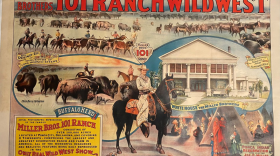On this date in 1919 the Hope Pioneer announced that the Equity Packing Plant had begun operations in West Fargo. John Haggart was the driving force behind the cooperative. He was born in 1846 in New York State where his father owned a farm. After serving in the Army, Haggart relocated to Dakota Territory and made one of the first land claims in the Red River Valley. He was a prosperous wheat farmer, and the area was first named Haggart, but is now known as West Fargo.
John Haggart was well-known in the area. He was the first man in the state to become a Mason. He was instrumental in forming the Fargo Southern Railroad. The six hundred residents of Fargo elected him town marshal in 1875 when the city was first incorporated. He was also the first sheriff of Cass County. And he even served as fire chief and deputy US Marshall.
In 1889 Haggart was elected to the first state senate, and he introduced the first bill, which authorized an appropriation for the North Dakota Agricultural College. He also helped ensure that the college would be in Fargo.
It was in 1916 that ranchers organized by Haggart established the cooperative meat packing plant. It took three years for the Equity Cooperative Packing Company to be built and begin operating. The company also built twenty-four houses for workers east of the Sheyenne River and north of Main Street. Spurred by the plant, the community saw the establishment of a hotel, general store, restaurant, and post office.
However, the plant was not a cooperative for long. After only a few years, the company declared bankruptcy, and the doors were shuttered in 1922. In 1925 Armour and Company bought it and resumed operations.
Henry Ford gets credited for inventing the assembly line, but Ford himself gave credit to the meat packing industry. Armour’s competitive edge was the assembly line. Armour also bragged it used “every part of the animal except the squeal.” In addition to food products, Armour produced adhesives, fertilizer, and soap.
The industry was so central to the community that the West Fargo High School athletic teams’ nick-name became “The Packers.” But the meat packing era ended when the Armour plant closed in 1960.
Dakota Datebook written by Carole Butcher
Sources:
Hope Pioneer. “News in Brief.” Hope ND. 3 July 1919. Page 5.
Fargo, North Dakota. “John Haggart.” https://library.ndsu.edu/fargo-history/?q=content/john-e-haggart Accessed 5/25/2020
City of West Fargo. “Beginnings.” https://www.westfargond.gov/410/About-West-Fargo Accessed 5/25/2020
NDSU. “History of Cattle Production in North Dakota.” https://www.ag.ndsu.edu/archive/streeter/2007report/beef_history/History_Beef_central.htm Accessed 5/25/2020



